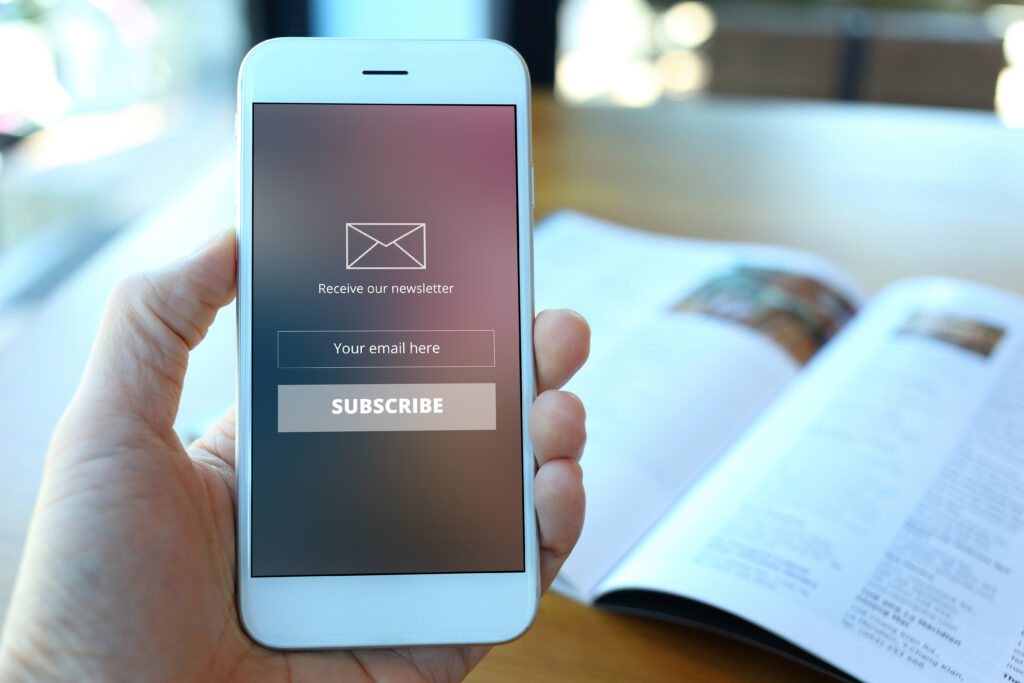If you’re looking to strengthen your business’s reach, B2B content marketing is one of the most effective ways to engage and convert other organisations.
B2B content marketing is the process of creating and sharing valuable content, such as blogs, case studies and podcasts, to attract, inform and build trust with business customers. Rather than selling directly, it focuses on providing answers, insights and solutions that matter to your professional audience.
By positioning your brand as a knowledgeable partner, you help decision-makers solve real challenges and guide them through complex buying journeys. Compelling content not only raises your profile, but also supports every stage of your sales funnel, from brand awareness to long-term loyalty. You’ll be able to see the impact of your efforts through increased website traffic, qualified leads and strengthened client relationships.
Whether you’re seeking to enhance your brand authority or generate new business opportunities, a strategic B2B content marketing plan can set your company apart from the competition and drive measurable results.
Core principles of B2B content marketing
B2B content marketing builds industry trust, positions your brand as an authority and supports your teams in converting prospects at every stage of the marketing funnel. It combines targeted insights with strategic content to connect with decision-makers and drive results for your business.
Definition and purpose
B2B content marketing is a strategy focused on creating and sharing valuable content tailored for other businesses. Instead of targeting individual consumers, you reach teams or decision-makers within organisations. Your aim is always to raise brand awareness, nurture leads and help your company stand out as a knowledgeable industry player.
Content formats include blog posts, case studies, white papers, emails and more. Each piece should reflect your brand voice, deliver useful information and directly address business challenges your audience faces. Relevant and timely content guides potential clients through the buyer journey and keeps them engaged with your brand.
Thought leadership is a core pillar. By offering actionable advice and unique perspectives, you demonstrate expertise and reliability. B2B marketers who deliver trustworthy, educational material will build credibility, win attention and make their brand indispensable.
Differences from B2C content marketing
While both B2B and B2C content marketing share some tactics, the goals and audience demands are different. B2B brands focus on the needs of professionals managing complex challenges within an organisation. Purchasing decisions usually involve several stakeholders and take longer.
Your content must be precise, in-depth and rooted in solving real business problems, not just building emotional appeal. Instead of quick sales, the focus is on establishing trust and building relationships over time through continuous lead nurturing.
Messaging is usually delivered in a professional tone with industry-appropriate language. However, it’s important to remember that some industries prefer a more laidback communication style, so it’s not a one-size-fits-all case when it comes to tone of voice.
Role in the marketing funnel
A well-executed B2B content strategy supports prospects throughout the marketing funnel, from initial awareness to lead generation and purchase. At the top, your content should introduce challenges relevant to your industry, provide educational resources and build brand awareness.
In the middle stages, more detailed materials such as case studies, eBooks and white papers address specific problems and help potential clients compare solutions. This stage is crucial for lead nurturing as B2B buyers often consult multiple stakeholders and require several rounds of decision-making.
Further down, your content should offer validation and facilitate consensus. Product demos, technical guides and testimonials build confidence and help decision-makers justify their choice. After winning their business, continue to engage clients with support materials and updates to create loyalty and ensure long-term success.
Developing a winning B2B content strategy
Building an effective B2B content strategy demands a deep understanding of your audience, strong planning and close alignment with your broader business goals.
Identifying and understanding your target audience
Understanding your target audience shapes every part of your B2B content strategy. Begin by mapping key decision-makers and influencers in your industry. Use audience segmentation to divide targets by sector, company size, job function and purchase intent. This approach lets you personalise content for C-level executives, technical leads or procurement managers.
Gather data from industry reports, customer interviews and sales team feedback to create user personas. Detailed buyer personas show the challenges, needs and questions of your ideal clients. Tools like LinkedIn and industry forums reveal trending issues.

For small businesses or marketing agencies, finding the right audience may mean focusing on niche markets. High-quality, relevant content builds trust and keeps your brand in your audience’s consideration set throughout a long buying cycle.
Content planning and editorial calendar
A robust editorial calendar is essential for maintaining consistency and high standards in your content output. Start by establishing content themes that directly address the priorities of your audience segments. Plan an even mix of formats, including case studies, white papers, thought leadership articles and industry news, to support different stages of the buying journey.
Map content topics to buyer personas and their questions. Use a spreadsheet or dedicated content calendar software to schedule posts, assign responsibilities and set deadlines. This keeps your marketing team, agency or freelancers accountable and ensures content gaps are addressed promptly.
The calendar should also highlight key industry events, product launches or seasonal priorities relevant to your B2B buyers. By linking each content piece to business goals, you can drive demand generation, not just brand awareness.
Content distribution and channel selection

Choosing the right channels for distribution is key to maximising customer engagement. Owned media, such as your website, blog, social channels or email newsletter, are fundamental. Social platforms like LinkedIn have high value for B2B, given their reach among decision-makers.
Explore online communities, relevant industry publications and partnership opportunities for co-marketing. Share content in multiple formats: videos, infographics and downloadable assets extend reach and collect qualified leads.
Support your sales team by equipping them with tailored content they can share directly with prospects. Regularly review analytics to understand which channels deliver the best ROI and refine your approach based on data-driven insights.
Aligning with sales and lead generation goals
Your B2B content strategy should work hand-in-hand with sales and lead generation efforts. Begin by involving your sales team early, gathering their knowledge of pain points and common objections. Structure your content to answer key questions, provide evidence and guide prospects through your sales funnel.
Set clear goals for each stage — top-of-the-funnel pieces should raise awareness, while case studies and testimonials will support decision-making at the bottom. Use calls to action (CTAs) and gated content, such as white papers or tools, to capture leads.
Review performance monthly with both sales and marketing teams and adjust your strategy to focus on high-performing topics and tactics that generate qualified leads. This collaboration ensures your B2B content delivers measurable impact and helps you reach and convert your ideal business client.
Essential B2B content types and formats
Using the right mix of B2B content types helps you address specific business goals, reach key decision-makers and guide prospects along the buyer’s journey. Each format plays a unique role, from building authority and trust to capturing leads and encouraging engagement with your brand.

Blog posts and thought leadership
Blog posts remain a cornerstone of any strategic B2B content plan. Through well-researched articles, you can demonstrate your industry expertise and address burning questions your clients are asking. Content that explains trends, best practices, and practical tips positions your brand as a thought leader in your sector.
Publishing regular, high-quality blogs that are SEO-optimised increases your visibility on search engines and drives organic traffic to your site. Senior decision-makers often search for trusted advice before reaching out, making this content type crucial for trust-building. To achieve real impact, ensure your content is notable for its clarity, accuracy and actionable insights.
Including innovative opinion pieces and interviews with your senior team adds depth and diversity. Sharing your latest articles through social media posts also increases social shares and brand awareness.
Case studies and white papers
Case studies and white papers are powerful tools to showcase your achievements and demonstrate how your solutions resolve concrete business challenges. A customer case study typically provides a clear narrative: outlining the client’s problem, the approach taken and the positive results you’ve delivered.
Sharing measurable outcomes, such as increased revenue or decreased downtime, adds credibility. White papers offer an in-depth look at complex topics, giving prospects the detailed research and analysis they need to inform their decisions.
These digital content formats are particularly effective as sales enablement documents. You can provide them as downloadable digital assets or feature them on dedicated landing pages to capture leads. Industry leaders often use case studies at events or in pitches to provide social proof and enhance trust with prospective clients.
Email newsletters and gated content
Email newsletters allow you to stay front-of-mind with your contacts while delivering valuable insights straight to their inbox. A well-crafted newsletter features company news, case study highlights, links to recent white papers and tips tailored to your client base.
Regular communication through email helps nurture relationships, encourage repeat engagement, and drive ongoing traffic to your website. Segmenting your lists allows you to tailor content according to client needs or business sectors.
Gated content such as eBooks, specialised guides and research reports can be used as lead magnets. Prospects provide their contact details in exchange for access, which helps you build your database and move leads further down the funnel. Placing this content behind a registration form on your landing page ensures only qualified leads access your most valuable resources.
Video and interactive content
Video marketing is a dynamic and engaging way to highlight complex products or services, especially if your audience is pressed for time. Product walkthroughs, explainer videos, customer testimonials and expert interviews can simplify technical concepts and reinforce your reputation as a knowledgeable partner.
Interactive content, such as quizzes, assessments and calculators, increases user engagement and collects valuable insights about your audience. Embedding short demo videos on your home or service pages also helps with retention and conversion rates, as visitors spend more time exploring your digital assets.
Social media platforms are ideal for sharing video snippets, driving further brand recognition and encouraging social shares. As B2B buyers expect more digital content during their research, well-produced video and interactive formats set you apart from competitors and support your clients throughout their decision-making journey.
Measuring and optimising B2B content performance
Delivering consistent content results in B2B marketing means applying clear, strategic measures to understand your content’s impact. Careful tracking, optimisation, and adaptation are key to driving valuable business outcomes and keeping ahead of rapid digital changes.
Setting KPIs and tracking metrics
To manage your content performance, you need to set clear KPIs (key performance indicators) that align with your business objectives. The most effective KPIs in B2B marketing include conversion rates, engagement rates and marketing qualified leads (MQLs). Tracking these will help you measure if your campaigns are generating true interest and actual revenue.
Modern analytics platforms such as Google Analytics provide detailed insights into how users interact with your website and which content converts best. Setting up custom dashboards allows you to monitor real-time data and trends, enabling rapid response to performance issues. Avoid relying solely on vanity metrics like just page views or impressions. Instead, prioritise metrics that directly impact your bottom line and long-term growth, such as leads to sales-qualified leads (SQLs), newsletter sign-ups and requests for demos.
SEO rankings and organic traffic
Achieving strong search engine rankings is an important tactic for generating sustained B2B leads. Your content should target relevant keywords, optimised through a combination of on-page SEO, technical SEO and backlink strategies.
Tools like Google Search Console and Google Analytics allow you to track keyword rankings, click-through rates (CTR) and user journeys from search engines to your site. High organic traffic signals that your SEO efforts are paying off, while a decline may indicate the need for strategy updates or new content.
Keeping a close eye on your keyword rankings for your most important phrases ensures you remain competitive in your sector.

Content audit and repurposing
A regular content audit reveals which assets are driving results and which are underperforming. During an audit, review key data points such as time on page, bounce rate, session duration and backlinks. Compare these against your business goals, and decide what should be updated, consolidated or retired.
Repurpose high-performing content into different formats to maximise reach. For example, turn a successful white paper into a webinar, infographics or bite-sized blog posts. Content repurposing not only drives more value from existing work, but also extends your reach across channels. Use analytics platforms to identify which assets perform best and pinpoint gaps or opportunities.
Frequently asked questions
Achieving results in B2B content marketing requires clear strategy, creative execution and a focus on building relationships with decision-makers. You need tailored approaches to strategy, practical examples and an understanding of the differences between B2B and B2C practices.
How can we develop an effective B2B content marketing strategy?
Start by defining measurable business goals, such as lead generation or brand awareness. Research your buyers thoroughly and develop detailed personas, so you know the real challenges they face.
Mapping your content to every stage of the buyer’s journey is crucial. Use tactics like regular competitor reviews and a well-structured content calendar to stay ahead.
What is the best way to create compelling content for B2B audiences?
Understand your audience’s needs and pain points through interviews and analytics. Focus on solving specific business challenges and prioritise education over sales messaging.
Practical formats include blog posts, in-depth guides and webinars. Repurpose key insights across platforms and stick to clear, authoritative language that promotes trust. Real-world case studies and industry data always add credibility.
How does a B2B content strategy framework differ from B2C?
B2B content marketing targets business decision-makers and takes a more logical, detailed approach. The buying cycle is longer and often involves more stakeholders.
Content is typically data-driven, focusing on ROI and expertise. By contrast, B2C content is more emotional, short-term and aims for quick sales. B2B content includes white papers and reports, while B2C often relies on social posts, product videos and customer reviews.
However, it’s important to note that content formats can cross both B2B and B2C content marketing — ultimately, it’s down to where your audience spends their time.


